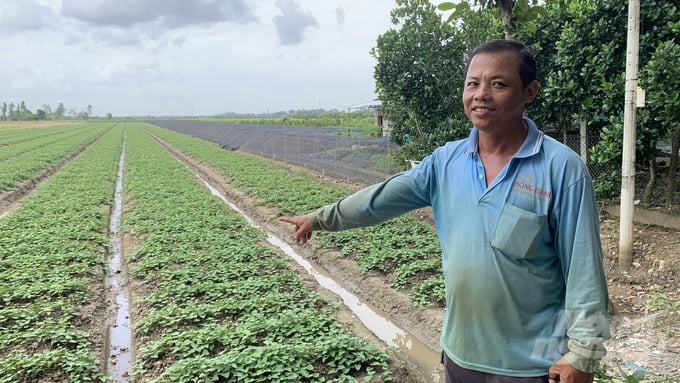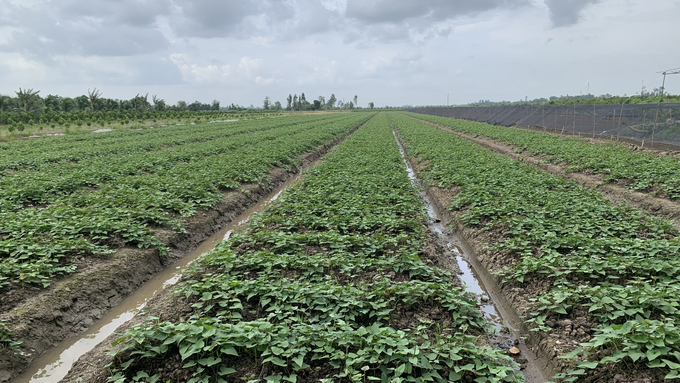May 21, 2025 | 09:27 GMT +7
May 21, 2025 | 09:27 GMT +7
Hotline: 0913.378.918
May 21, 2025 | 09:27 GMT +7
Hotline: 0913.378.918

Farmers in Tan Phu hamlet, Tan Binh commune (Binh Tan district, Vinh Long province) are participating in a training session on monitoring beneficial insect density in sweet potato fields. Photo: Ho Thao.
Binh Tan district is the largest sweet potato cultivation area in Vinh Long province, with an annual planting area of over 1.000ha. Farmers still maintain the habit of using chemical pesticides periodically (every 7 to 10 days) to prevent pests and diseases. This overuse not only disrupts the ecological balance but also leads to pest resistance, creating long-term challenges for crop health. Furthermore, the excessive use of pesticides results in environmental pollution, which poses serious health risks to the community. Besides, they also inflate production costs, putting a financial strain on farmers. When sweet potato prices decline, many of these farmers struggle to cover their expenses, leading to losses that force them to consider switching to alternative crops.
According to the Department of Agriculture and Rural Development of Binh Tan district, by the end of September 2024, the area dedicated to sweet potato cultivation in the district is projected to shrink to only 805ha, a reduction of 218ha compared to the same period last year.
To promote sustainable production, protect the environment, and create safe products, the Plant Cultivation and Plant Protection Sub-Department of Vinh Long province has implemented the 'Integrated plant health management (IPHM) model for sweet potato cultivation" in Binh Tan district.
The model is being implemented in Tan Binh commune over an area of 24ha, with participation from 30 households. Within this model, farmers are adopting practices that reduce seed usage from 2 muon/1.000m² to 1,6 muon (with 1 muon equaling 10.000 seeds). The use of chemical fertilizers has been cut back, with part of it replaced by organic fertilizers, and the frequency of pesticide applications has been reduced by two times compared to previous practices.
Each week, farmers monitor and record various criteria, including the number of leaves, the length of the sweet potato vines, the total number of tubers, the percentage of tubers affected by pests, incidence of tuber rot, and the density of beneficial insect species. Additionally, the sweet potato fields within the model are incorporating technical advancements such as the '3 reductions, 3 increases' approach, '1 must, 5 reductions', and Integrated Pest Management (IPM) strategies.

The sweet potato fields in the IPHM model are growing very well. Photo: Ho Thao.
Recently, in Tan Phu hamlet, Tan Binh commune (Binh Tan district), over 30 farming households attended the concluding session of the "Integrated plant health management" (IPHM) model for sweet potato cultivation. This was their first experience applying the new farming process, and they were eager to participate to verify its effectiveness.
The results showed that fields utilizing the IPHM model achieved a yield of 3.7 tons/rod (1 rod = 1.000m²), which is 1 ton higher than the control fields. After deducting expenses, farmers earned nearly 465 USD/rod, resulting in an additional profit of 850 USD/ha. The farmers expressed their excitement, noting that this is the highest profit level they have seen in the past two years compared to the same period.
Mr. Vo Van Tan from Tan Phu hamlet shared: "At first, I was quite worried when the staff advised me to reduce the seed density by 4.000 seeds/rod because I feared that planting too sparsely would lower the yield. However, in reality, maintaining a moderate planting density allows the sweet potato plants to grow quickly, leading to deeper and larger tubers, resulting in higher yields. Additionally, the percentage of tubers affected by pests and grubs has decreased".
Mr. Tan noted that thanks to the training, he has gained a solid understanding of the life cycle of pests and diseases, allowing him to apply pesticides at the right time. This has helped him reduce the cost of purchasing pesticides from approximately 380 USD/rod/season to about 215 USD, as well as decrease the labor needed for spraying.
"About 15 to 20 days after planting, when leaf pests begin to appear, I spray pesticide for the first time and then stop. When the sweet potatoes start to form tubers and pests like grubs and crickets develop, I water the pesticide at the base", Mr. Tan said.
According to Mr. Tan, in the past, farmers often planted sweet potatoes continuously for 2 to 3 crops a year, which led to soil depletion and outbreaks of pests from previous crops. Since receiving training, Mr. Tan has applied the method of rotating one crop of sweet potatoes with one crop of rice to improve soil quality and reduce pest risks. As a result, his sweet potato field yields 55 quintals/rod, 10 quintals more than neighboring fields, with a profit of 2.917 USD/ha.
"After this harvest, I am preparing to irrigate the soil and will expand by an additional 50 rods according to the IPHM process I have been instructed", Mr. Tan said.

Compared to the control field, the profit from the model field applying IPHM increased by an additional 83 USD/rod, bringing the total profit to about 4.166 USD/ha. Photo: MH.
Similar to Mr. Tan, Mr. Nguyen Van Phuc (who lives in the same hamlet) is also harvesting his sweet potato field, achieving a yield of 62 quintals/rod (1 quintal = 60 kg), which is 15 quintals higher than the fields outside the model. Mr. Phuc shared that not only is his field yielding high, but the profit is also outstanding, increasing by nearly 83 USD/rod compared to traditional farming methods.
"The fields outside the model incur higher costs due to using more seed varieties, while my field has reduced 4.000 cuttings of seed, saving about 11.5 USD/rod. Fertilizer has also decreased to 20 kg/ 1.000 m², saving an additional 14.5 USD. The amount spent on pesticides is lower by up to 33 USD/rod thanks to fewer sprayings", Mr. Phuc analyzed and confirmed that he will definitely continue applying the IPHM process in the next harvest.
According to Mrs. Tran Thi Hong Thoi, a technical officer at the Plant Protection Station in Binh Tan District, the results indicate that IPHM is the leading solution for sweet potato cultivation today. The model not only brings economic efficiency but also helps raise farmers' awareness of applying scientific and technological advancements in production, particularly measures such as adhering to seasonal schedules, rotating with other crop families, and simultaneously combining various farming methods, as well as integrating biological and chemical solutions.
We will propose to the Department of Agriculture and Rural Development and the People's Committees of the communes to continue monitoring and encouraging households that have participated in the model to maintain and expand their scale in the coming years", Mrs. Thoi said.
Mr. Nguyen Vinh Phuc, the Head of the Plant Cultivation and Plant Protection Sub-Department of Vinh Long Province, assessed that sweet potato farmers in Binh Tan District are currently facing numerous risks throughout the entire process, from production to consumption. One of the significant challenges is the overuse of pesticides, which leads to high costs; in fact, expenditures on pest control account for approximately 30-35% of the total production costs.
Mr. Phuc emphasized the need for farmers to change their mindset and adopt new farming practices by incorporating technological advancements. He highlighted that this shift is essential not only for maintaining the health of the soil and crops but also for reducing the costs of production inputs.

The sweet potato raw material area in Vĩnh Long Province will enhance the application of IPHM in the upcoming period. Photo: Ho Thao.
The application of IPM and IPHM practices will contribute to sustainable production, protect the environment, safeguard public health, and create safe products. Additionally, it will help revitalize the sweet potato raw material area of the province in the coming years. The province has also approved a plan for the development of Integrated Plant Health Management (IPHM) until 2030, applicable to various crops such as sweet potatoes, rice and jackfruit.
Translated by Phuong Linh

(VAN) Facing the threat of rabies spreading to the community, Gia Lai province urgently carries out measures to vaccinate dogs and cats on a large scale.

(VAN) Disease-free livestock farming not only protects livestock herds but also stabilizes production and livelihoods for many farmers in Tuyen Quang.

(VAN) Japan's grant aid project contributes to capacity building, promoting organic agricultural production, and fostering sustainable community development in Dong Thap province.

(VAN) For years, the CRISPR-Cas9 genome technology has been reshaping genetic engineering, a precision tool to transform everything from agriculture to medicine.

(VAN) Vietnam aims to become a 'leader' in the region in the capacity and managing effectively soil health and crop nutrition.
![Reducing emissions from rice fields: [Part 1] Farming clean rice together](https://t.ex-cdn.com/nongnghiepmoitruong.vn/608w/files/news/2025/05/05/z6509661417740_a647202949c539012a959e841c03e1d3-nongnghiep-143611.jpg)
(VAN) Growing clean rice helps reduce environmental pollution while increasing income, allowing farmers to feel secure in production and remain committed to their fields for the long term.
/2025/05/19/5136-1-144800_230.jpg)
(VAN) The Nghe An Provincial People's Committee has just approved the list of beneficiaries eligible for revenue from the Emission Reductions Payment Agreement (ERPA) in the North Central region for the year 2025.